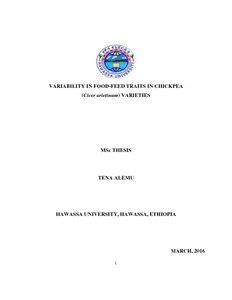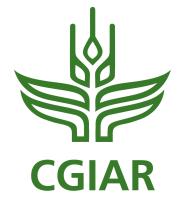Resource information
The study was conducted with the objectives of analyzing and developing Near Infrared Reflectance Spectroscopy (NIRS) equation for predicting nutritional value and mineral constituents of chickpea haulm, and to determine the relationship between fodder quality and agronomic traits of chickpea. The samples were collected from Akaki, Alem Tena, Chefe Donsa, Debre-zeit and Minjar field experimental sites of Debre zeit Agricultural Research Center and the laboratory work was conducted at Animal Nutrition laboratory of the International Livestock Research Institute (ILRI), Addis Ababa. A total of 105 tested and 8 control genotypes with 1348 samples of chickpea haulms from preliminary and national variety trials were used for NIRS prediction. Calibration models were developed between chemical and NIRS spectral data. Randomized Complete Block Design with 4 replications was used in the experiment. The plot size was 4m x 1.2m (4rows/plot), 30cm between rows and about 10cm between plants spacing was used. All management activities were done. Statistical analysis of the data was carried out using the General Linear Model (GLM) procedure of SAS (Statistical Analysis System) used for analyzing the data with samples of 597 chickpea haulms from national variety trials. The model developed by NIRS for the prediction of chickpea haulm Crude Protein (CP), ME (Metabolizable Energy), TIVOMD(True In Vitro Organic Matter Digestibility) values and fiber fractions were accurate and successful method. The coefficients of determination for Calibration (r2c), validation (r2v) and Ratio Performance Deviation (RPD) of chemical constituents were within the range of 0.97-0.99, 0.96-0.99 and 3.61-26, respectively. The r2c, r2v and RPD for minerals were between the range of 0.71-0.99, 0.68-0.92 and 1.58-3.55, respectively. Higher CP value was recorded in kabuli and desi type chickpea at Debre zeit, Alem Tena and Minjar locations. Dz2012ck0084 and dz2012ck0018 had higher (P<0.05) CP, ME, TIVOMD and lower in fiber fractions for moisture stress area. On the other hand, dz2012ck0036 had higher grain yield. The CP content of the haulm was significantly (p<0.001) higher and negatively correlated with days to 90% maturity (DTM), grain yield (GYLD), biomass (BM) and haulm yield (HYLD). Moreover, the ME and TIVOMD were negatively correlated to all agronomic traits, except hundred seed weight (HSW). The highest correlation coefficient with strong associations (p<0.001) were observed for BM with HYLD (r=0.90), BM with GYLD (r=0.82), GYLD with HYLD (r= 0.51) and DTF with DTM (r= 0.63). Grain yield was positively and significant (p<0.001) correlated with DTM and BM and also significantly (p<0.001) and negatively correlated with HSW. Genotypes which combined moderately high grain and haulm yield, better haulm quality traits and ultimately medium potential utility index were Dz2012ck000024, Ejere, Chefe and Dz2012ck0017 from kabuli for moisture stress area, Dz2012ck0007, Dz2012ck0001, Dz2012ck0012, Arerti and Dz2012ck0004 from kabuli for potential environment, Dz2012ck0036, Dz2012ck0031 and Dz2012ck0029 and Natoli from desi type chickpea. Generally, the present showed the possibility for simultaneous improvement of high grain and haulm yield with desirable haulm quality traits to address the high demand existing for dual purpose food-feed traits of chickpea genotypes in mixed-livestock system of Ethiopia.



